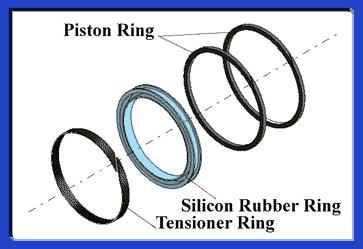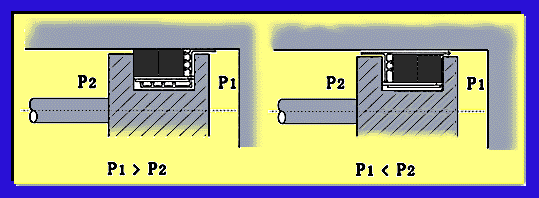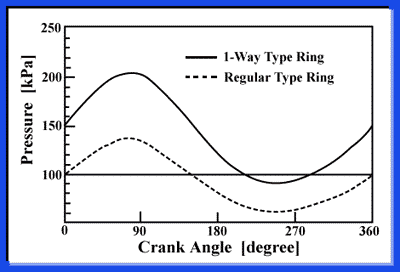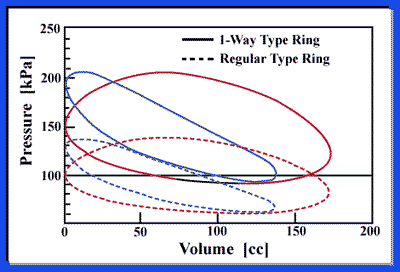
The one way piston ring
 Japanese
Japanese
Generary Stirling engine is a closed cycle engine differ from Gasoline engine, then it isn't necessary to exchange gas with engine inside and outside and can make the structure very easy, In order to realize the closed cycle however, it is very important to keep off the gas leakage.
Stirling engine has thermal efficiency that is equal to Carnot efficiency theoretically, in order to realize this high thermal efficiency, a heat exchanger (that is colled Regenerator) compose in the engine. The regenerator is made with a net of stainless steel made generally, and receive and supply heat when gas goes and returns for a high-temperature side and low temperature. As this regenerator becomes dirty with oil it results a harmful influence that is a fall of heat transmit performance or increasing flow friction. Therefore it is considered that it is not able to use oil for lubrication of a piston ring with Stirling engine generally. Lubrication depending on oil has a role that it keep off the gas leakage not only friction reducing, and many problems arise sealing of a piston on Stirling engine for that reason.
The one way piston ring, developed our Labratory, bring about for a solution concerning this problem, by using a behavior of the pressure positively. This piston ring, by a difference with an inside pressure and an outside pressure, in case that an inside pressure is high, ring keep off the gas leakage, on the other hand, out side is high it inhale gas from engine outside. As a result the minimum pressure of working gas in engine is close to buffer pressure and engine's work increase.

 Structure of the one way piston ring
Structure of the one way piston ring
The one way piston ring is composed by a four part. From the each out side, 2 piston rings of Tefron made to seal up a gap of a cylinder and a piston actually, Silicon rubber made ring, tensioner ring of metal made are. Among of them, Silicon rubber ring is important to make the behavior of "1-way" character. A pressure for a cylinder serface by the piston ring changes depending on a pressure difference with inside and outside by the peculiar shape of this ring from. Loosen a tension and urge into an inhalation of gas, when an external pressure is high, as increasing a tension, when an inside pressure is high after all, reduce a leak of gas. Then an average pressure of working gas in engine increase higher than the outside. As the result improvement of output of an engine is possible.

 Working principle
Working principle
When pressure P1 is higher than P2 like a figure of the left side, seal rings are pressed by P1 and moved on the side of P2. Then the gas frow into a back of a ring from nicks of a rubber ring and press the seal rings for the out side. As the result, a leak is decreased. when P2 are higher than P1 contrariwise, though the seal rings are pressed on the side of P1, however the nichs are not on this side and gas doesn't flow to a back of a ring. Then tension to a cylinder wall of the seal rings come from tensioner ring only. As the result, gas can easily inflow to the side of P1.
 Technical data
Technical data
The one way piston ring is used for many engines of our laboratory, and these engines increase output power by this ring. We present some experimental datas obtained by the horizontally opposed type Stirling engine.
 This figure shows the relation between working gas pressure and crank angle. By using the one way piston ring, the minimum pressure rises close to a buffer pressure, and it is obvious that pressure amplitude is getting largeer than by case of using general 3 pieces type.
This figure shows the relation between working gas pressure and crank angle. By using the one way piston ring, the minimum pressure rises close to a buffer pressure, and it is obvious that pressure amplitude is getting largeer than by case of using general 3 pieces type.
 This figure shows the variation of a working gas pressure for a movement of a piston. The areas to be enclosed by these curves mean the work done by the engine. The red line shows the expansion side work and a blue line does compression side. by using the one way piston ring, area enclosed is swell then engine work is increased.
This figure shows the variation of a working gas pressure for a movement of a piston. The areas to be enclosed by these curves mean the work done by the engine. The red line shows the expansion side work and a blue line does compression side. by using the one way piston ring, area enclosed is swell then engine work is increased.
 Return to Stirling Engines of Saitama University
Return to Stirling Engines of Saitama University
 Return to Stirling Engiene Home Page Academic Edition
Return to Stirling Engiene Home Page Academic Edition
 This figure shows the relation between working gas pressure and crank angle. By using the one way piston ring, the minimum pressure rises close to a buffer pressure, and it is obvious that pressure amplitude is getting largeer than by case of using general 3 pieces type.
This figure shows the relation between working gas pressure and crank angle. By using the one way piston ring, the minimum pressure rises close to a buffer pressure, and it is obvious that pressure amplitude is getting largeer than by case of using general 3 pieces type.
 Japanese
Japanese
 Structure of the one way piston ring
Structure of the one way piston ring
 This figure shows the variation of a working gas pressure for a movement of a piston. The areas to be enclosed by these curves mean the work done by the engine. The red line shows the expansion side work and a blue line does compression side. by using the one way piston ring, area enclosed is swell then engine work is increased.
This figure shows the variation of a working gas pressure for a movement of a piston. The areas to be enclosed by these curves mean the work done by the engine. The red line shows the expansion side work and a blue line does compression side. by using the one way piston ring, area enclosed is swell then engine work is increased. Return to Stirling Engines of Saitama University
Return to Stirling Engines of Saitama University Return to Stirling Engiene Home Page Academic Edition
Return to Stirling Engiene Home Page Academic Edition